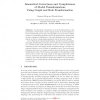Free Online Productivity Tools
i2Speak
i2Symbol
i2OCR
iTex2Img
iWeb2Print
iWeb2Shot
i2Type
iPdf2Split
iPdf2Merge
i2Bopomofo
i2Arabic
i2Style
i2Image
i2PDF
iLatex2Rtf
Sci2ools
GG
2008
Springer
2008
Springer
Semantical Correctness and Completeness of Model Transformations Using Graph and Rule Transformation
An important requirement of model transformations is the preservation of the behavior of the original model. A model transformation is semantically correct if for each simulation run of the source system we find a corresponding simulation run in the target system. Analogously, we have semantical completeness, if for each simulation run of the target system we find a corresponding simulation run in the source system. In our framework of graph transformation, models are given by graphs, and graph transformation rules are used to define the operational behavior of visual models (called simulation rules). In order to compare the semantics of source and target models, we assume that in both cases operational behavior can be defined by simulation rules. The model transformation from source to target models is given by another set of graph transformation rules. These rules are also applied to the simulation rules of the source model. The main result in this paper states the conditions for...
Corresponding Simulation Run | GG 2008 | Model Transformation | Simulation Run | Theoretical Computer Science |
| Added | 09 Nov 2010 |
| Updated | 09 Nov 2010 |
| Type | Conference |
| Year | 2008 |
| Where | GG |
| Authors | Hartmut Ehrig, Claudia Ermel |
Comments (0)

